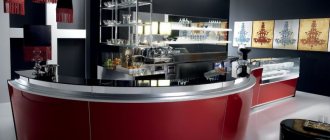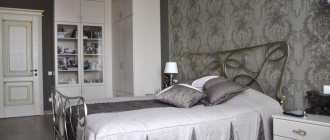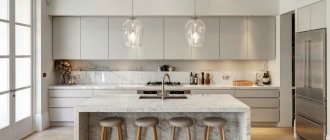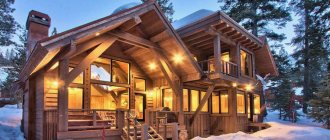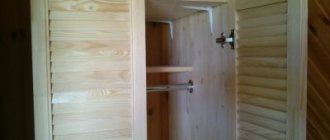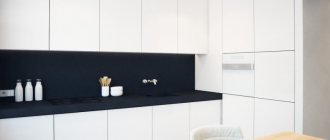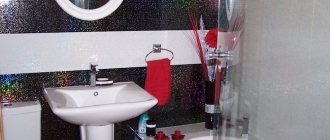Good lighting is important in any room, but especially in the kitchen. A lot depends on how correctly you plan the light here: the convenience of kitchen chores, the hostess’s mood, and even the quality of the prepared dishes.
And if your kitchen also serves as a dining room, you certainly cannot do without welcoming lighting.
How to choose this important element correctly and plan everything in advance? That's what our detailed guide is all about, including the 25 best kitchen lighting tips. You will learn:
- why diverse lighting is so important in the kitchen, when and how to plan it;
- what is the difference between local (local) light for the food preparation area and lighting for the dining table;
- what types of lighting are optimal near work surfaces, and what types are optimal for cabinets;
- what types of lamps designers choose for different purposes (spotlights with halogen lamps, LEDs, spots, pendant lamps, etc.);
- how to choose the right lighting for a small and large kitchen;
- how to provide sufficient luminous flux to save energy;
- how to make a lighting plan correctly if you are your own designer.
Find out the answers to these and other questions, and also look at a large collection of examples - 85 photos of examples of lighting in the kitchen .
__________________________
general tips for lighting in the kitchen
Let's start with the main thing: when to plan lighting?
The best time is at the time of repair. This is how you can save yourself from additional gating of walls and ceilings, as well as from regrets about insufficiently convenient light.
The most important thing is the location (wire output) and the presence of switches. And you can decide on the type of lamp, lamp power and lampshade design much later. Including when the renovation is already completed.
How to make a lighting diagram in a kitchen for builders (electricians), if you are not a designer and do not do renovations professionally?
This is, of course, more complicated than a partition plan. But a simplified version is better than no version at all. But it is very advisable to discuss the nuances (the ability to do what you want and the price of the issue) in detail with your electrician. More on this at the end of this guide (section “How to make a kitchen lighting plan”).
1-1. Different lighting for different purposes.
Before planning your lighting, ask yourself: what does your kitchen serve for other than cooking? Quick coffee, leisurely lunches and dinners, meetings with friends - or all of the above? The more zones in your kitchen, the more light there should be. The ideal option is general lighting + as many additional lamps as necessary.
Look at the photographs of these kitchens: the lighting in them is planned very competently - each for different purposes. This, by the way, is also practical - from the point of view of saving energy without compromising light comfort.
1-2. General (overhead) lighting.
In the kitchen, it is very important to provide a uniform “background” ceiling light. And it’s better if such lamps are distributed throughout the kitchen. For general (background) lighting, one lamp of 40-60 W per square meter is recommended. However, there may be more of them if the ceiling is very high.
1-3. Local (local) lighting.
Even the smallest kitchen requires local lighting. And the more different zones, the more lamps there should be. Moreover, their power can be much less than if only general (ceiling) lighting was used. And less energy will be spent if the light is turned on only where it is needed.
Read more about what zones there can be in the kitchen and how to properly light them in the following sections of this guide.
1-4. Decorative light.
Who said lighting should only be practical? Decorative (accent) light is ideal if you want to rid the kitchen of a purely utilitarian appearance.
The flow of light here is usually minimal, but a spectacular and fashionable look is guaranteed. The bottom and top of cabinets, shelves in a buffet - you can choose either a neutral shade of light or a colored one. LEDs do this best.
__________________________
Venice at the Arctic Circle
Solovetsky canals, dug by monks in the 17th century.
Peace and tranquility, which is not felt in the monastery, can be found either on one of the smaller islands, where monasteries were built in ancient times, or move deeper into Bolshoi Solovetsky.
But even in the second case, when you are undoubtedly moving away from the sea, the path will run along the water.
Lakes, large and small, with a total number of more than 300, were here before the monks Savvaty and Zosima landed on the archipelago. Tireless workers in cassocks connected them with a network of real canals, turning them into a transport system that was much more convenient than bumpy, crooked roads that were not passable at all times of the year. One can only guess how many hands were rubbed into blood, how many spades were knocked down, but it may well be that it is not water that flows in the canals, but the sweat spilled during their construction.
At the end of the 19th century, even tiny steamboats traveled along them, dragging strings of rafts and boats behind them.
Now there is silence and tranquility on the canals, only the noise of the forests growing along the banks and the quack of ducks. The shores, fortified with stones and wooden pillars, have been preserved; in some places you can see the remains of real, albeit small, locks, and half-rotten piers that have sunk under the water.
Sometimes the width of the waterway is such that you hit the ground with oars on one side and the other, and then you have to use one of them as a pole, pushing off from the bottom. One push, another, the thickets scatter, and you find yourself on the surface of a lake large enough for yachts to sail on it, and the sun plays merrily on the bluish-gray waves.
15 minutes of rowing, and you dive into the next mouth: you are again enveloped in silent darkness, where the smells of pine needles and fresh greenery reign, the sky is covered by the crowns closed overhead, and visibility is limited by two rows of trunks, similar to gray and white columns.
This is a real labyrinth, stretching for kilometers and kilometers, and without a guide it is no more difficult to get lost here than in the jungle. The weather changes rapidly, the sun disappears, as if it had been turned off, it begins to drizzle, then a chilly wind blows in from the Arctic Ocean, and then it becomes warm and dry again, and all this in just half an hour.
Here, instead of a gondolier, a forest bird will sing a song to you, above your head there will be not an ancient elegant bridge with hurrying tourists, but branches with squirrels sitting on them, dense thickets take the place of buildings, and in general there are very few traces of people on land.
But the web of canals is no less picturesque than in Venice, the air and water are much cleaner, and through the changing landscapes, as if straight from the canvases of Russian painters of the 19th century, the same deep light peeks through.
And the cry of wild geese that fly overhead is like a prayer.
kitchen work area lighting
The main part of the kitchen and the place where the need for comfortable light can be equated to desktop lighting. If possible, separate multiple areas. The larger the size of the kitchen, the greater the scope for variations in the lighting of the work area.
2-1. Pay special attention to the work surface.
The food preparation area should be ideally lit - this is not so much an aesthetics as a safety requirement. There are two optimal solutions, choose which one seems more convenient to you:
- wall lighting (on the “work apron” between the upper and lower cabinets), photos 1 and 2
- suspended directional, installed on the ceiling, photos 3 and 4.
2-2. Second level ceiling or cornice.
If there is no free space on the wall, but there is (or is planned) a second level of ceiling, install spotlights in it. They will perfectly cope with two roles - (a) task lighting and (b) general lighting.
2-3. Hood with built-in lamps.
Another light option for convenient cooking. Hood lamps don't use a lot of energy, but they are powerful enough to illuminate both the stove and the small area around it.
2-4. Light near the sink.
This technique is not used often, but additional comfort is provided to the hostess. If you decide to make such lighting, be sure to make sure that the lamps are well protected by shades (glass or plastic).
2-5. Light under open shelves.
In the next section, we'll talk in detail about lighting around cabinets, including underneath them. What if there are no wall cabinets? Or do you want softer lighting for your work area? There is an elegant solution - use shelves with bottom lighting.
As a rule, these are not cheap design solutions. And if you want to save money, install LEDs under the shelves, similar to those you will see in the “LEDs for cabinets” section.
__________________________
kitchen cabinets and lighting
This section is all about light around kitchen cabinets (under, inside and above them). And also about what type of lamps will be useful for different purposes.
3-1. Spotlights (halogen) under cabinets.
Here we are talking about furniture spotlights. There is a common misconception that they will cope with the role of “work lighting”. This is far from true.
Judge for yourself: the depth of hanging cabinets is usually about 30 cm, the lamps are located in the middle (i.e., approximately 18-20 cm from the wall). The depth of the tabletop is 60-65 cm. The flow of light is directed downward and diffuses slightly. Now count: what part of the tabletop will remain unlit? More than 2/3, and on the side where you need it.
Do they even make sense? Of course, they are perfect for other purposes:
- night and evening “orienting” lighting (when there is no need to turn on the overhead light or work light);
- cozy lighting for preparing simple food and drinks;
- a comfortable light option for those who “wake up” only at breakfast, but quite early (when it’s still dark outside or just getting light).
3-2. LEDs - for the cooking area.
Modern professional chefs are confident that when cooking, not only the abundance of light is important, but also its correct “color temperature.” Simply put, lighting should not distort the colors of food.
If you consider yourself a gourmet, but at the same time treat cooking as an art, the best option for you is LED lamps with a high color rendering index.
They are usually mounted under cabinets. And such lamps will successfully replace other types of “working” lighting above the tabletop.
3-3. Interior lighting for kitchen cabinets.
Hard-to-reach areas need lighting just as much, if not more. In addition, you will not need to turn on the overhead light, just a couple of small light bulbs that will light up when the door is opened (special sensor).
The ideal lamp for the inside of the cabinet is small, 10 - 20 W. If the cabinet is tall or the distance between the shelves is large, you can choose furniture lamps with halogen lamps. If the cabinet is small or has glass shelves, choose overhead spotlights with LEDs. The third option (quite rare) is thin fluorescent tubes.
3-4. Lighting in drawers.
It's also very convenient. Miniature lamps are mounted on the walls of the box and turn on automatically when opened using a motion sensor. Such lamps are durable and consume little energy, which makes them an indispensable assistant for the housewife.
3-5. Mini-soffits above cabinets.
This solution is often found in the new version of IKEA METHOD kitchens. Optimal if you have a lot of cabinets with solid (not glazed) doors. Such lamps with directional local light (mini-spotlight) are installed on the upper cornice and well illuminate the inside of the cabinets when you open them.
__________________________
How to choose countertop material
The appearance, characteristics and service life of bar kitchen furniture will depend on the selected material. Modern durable racks are made from 4 types of materials. When choosing, focus on the rest of the furniture in the room: it is better if all the countertops are the same in texture.
Fake diamond
Countertops made of artificial stone are durable, stylish and look like natural texture. They are more affordable than natural stone, but much easier to maintain. The surface of the tabletop is resistant to moisture and household chemicals.
A natural stone
Natural stone countertops made of marble, granite, and onyx look luxurious. This is a premium product with a unique natural pattern, veining and color transitions, which is worth the investment. Natural stone is durable, but requires regular maintenance.
Cross section of the tree
A solid wood tabletop is another premium option. It will look great in an eco-style or Scandinavian style interior, especially in combination with the same wooden facades. To prevent natural wood from being damaged by moisture, choose high-quality material with impregnation, and then regularly repeat the treatment with special means.
Read on the topic: Kitchen interior in the style of eco-minimalism
Glass
You can get an impressive bar-style kitchen if you choose a model made of durable tempered glass. This is a multi-layer material designed to withstand heavy loads - don’t be fooled by its visual lightness. The tabletop can be used as usual: lean on it, serve, place small kitchen appliances on the glass surface.
directional local lighting
As a rule, these are “spotlights” - lamps with a narrow stream of light directed at a selected area. They usually have a conical shade (metal or glass) and can be rotated in different directions. This makes them especially convenient for the kitchen, allowing you to illuminate the desired area.
4-1. Ceiling soffits.
Typically used for general (overhead) lighting. The most convenient are a module of several spotlight lamps on a single base (“ceiling rail”), photos 1 and 2. The lamps can be turned in different directions (the kitchen is illuminated more evenly), but there is only one electrical outlet (economical in terms of electrical costs).
Sometimes there are variations: single spotlights are sometimes hung on the ceiling at different points (photo 4) or several modules with a thin base and small lampshades - for a large kitchen with high ceilings (photo 3).
4-2. Wall directional light.
This solution is used for directional lighting at a height of 1.50-1.80 m from the floor. If placed well, it can serve as a work light.
4-3. Rotating wall lamps that change the angle of inclination.
Quite a rare solution here, but very popular in Europe. This is a wall-mounted modification of the work lamp with a long adjustable stand. Allows you to illuminate the distant part of the table or the near one. A more compact option is a wall sconce with a rotating base (photo 3).
__________________________
Design matters
Lighting in restaurants directly depends on the style in which the room will be decorated. Let's look at the most popular options:
- classic interior. Bright light is used here. Therefore, a large crystal chandelier under the ceiling and lamps of complex shapes would be an excellent solution. Zoning can be organized using table lamps;
Classic interior
- themed interior. Especially popular lately. Here the light system is completely subordinate to the general idea. In this case, the lamps will be stylized to match a particular theme;
Thematic interior
- restaurant-club. Such establishments have a certain circle of visitors. Therefore, when creating lighting, it is necessary to take into account the preferences of the target audience. To create the appropriate atmosphere, you can use both classic and stylized lamps.
Having chosen the design style, you can begin installing the necessary lighting fixtures.
lighting of various additional kitchen areas
The number of zones is usually determined by the size of the kitchen. See what lighting designers recommend for different areas.
5-1. Warm light - for the dining area.
If your kitchen also doubles as a dining room, consider adding warm and cozy lighting above the dining table. Pendant lamps are best (one of a pair is the size of the table). To prevent light from shining into your eyes, make sure there is at least 80 cm between the lamp and the table.
5-2. Pendant lamps above the bar counter.
In addition to creating a special atmosphere, such lamps can add a touch of your favorite style to the kitchen. Or highlight the one that is already there. It is very convenient if the cord of such bar lamps is adjustable in length, allowing you to raise or lower the light relative to the bar counter.
5-3. Don't forget about the kitchen island.
This piece of furniture can serve a wide variety of roles, each requiring specific lighting. Think about what suits you best: pendant lamps, halogen lamps or adjustable sconces.
5-4. Light in the closet.
Whatever size your pantry is, it should have very good light. If this is a separate room with a door, you can install lamps with a motion sensor (eliminates the need to turn off the lights when your hands are full of food).
If your pantry is just a very large compartment (or closet), install lights on the side to illuminate all the shelves.
If there are glass doors between the kitchen and the pantry, less light will be needed (you partially use the light in the kitchen and natural light during the day). If the ceilings are high, it may be necessary to install more powerful lamps on the upper shelves.
5-5. Home office in the kitchen.
It's simple here: approach lighting the same way you would choose lighting for your desk in any other room. A table lamp connected to the nearest outlet is the best option. If there is not enough space on the countertop, look for a directional lamp on the wall (a working version of a sconce).
__________________________
Modern bar counter models
Modern models are distinguished by a variety of shapes, colors, types of designs and other details. A bar table for the kitchen can be purchased ready-made in a specialized store or made with your own hands. In both cases, it is necessary to provide for all important nuances at the planning stage of this element.
A beautiful bar counter can be a good addition to any apartment, house or modern cottage.
To summarize the article, let us once again list the most important aspects:
- Before you start making or buying a counter, you need to think about its location in the kitchen.
- The type of design will depend on the location and required functionality. Different options differ in appearance, functionality and cost; it is important to understand what requirements the bar counter must meet.
- It is important to pay attention to the material from which the furniture is made. This directly affects its wear resistance and durability, as well as cost and appearance.
- It is necessary to choose the design and coloring in accordance with the style of the room.
- For ease of use and comfort, it is necessary to consider lighting sources in the bar area. In addition to lamps, additional design elements can complement the picture.
Such furniture will give an original look to the interior and emphasize its unusualness.
Using the recommendations from this article, everyone will be able to choose or make a suitable bar counter on their own, but in the meantime you can familiarize yourself with a selection of photos of real examples of finished structures.
This way you will create a bright accent in the room that will attract everyone's attention.
Additional tips for planning kitchen lighting
And a few more design secrets on the topic of lighting, which relate not to the choice of lamps, but to other related issues.
6-1. More natural light.
The ideal lighting for the kitchen is a combination of natural and artificial light. Of course, we are not able to regulate the power of sunlight. But planning the kitchen so that nothing interferes with the circulation of daylight is quite possible.
6-2. Cozy light.
If you want to make your kitchen not only practical, but also comfortable, choose diffused light. Or hide the lamps behind the cornices of kitchen cabinets. They will do a great job illuminating the passage and walls.
6-3. Reflective materials.
Lacquered surfaces, steel, glass and anything white - these are the materials that will help fill the entire kitchen with light. However, do not forget about safety: the kitchen is not the place where dazzling shine is appropriate.
__________________________
Paths of the Shamans
Stone labyrinth on Bolshoi Zayatsky Island
You will encounter a completely different landscape when you go to the Zayatsky Islands.
There is no real forest here, only dwarf trees grow, birches and rowan trees half a meter high, the only buildings are the Church of St. Andrew, built during the time of Peter the Great, as well as a pier and several storage sheds from the same era.
Most of the island is occupied by tundra, and rock labyrinths are hidden in it. Laid out of gray stones, worn by time and storms, the spirals are buried in bright green moss, all different in structure and appearance, huge, up to several tens of meters in diameter.
Moreover, they are arranged in such a way that it is impossible to see the labyrinth from any point. Some have a center marked by a boulder or even several placed on top of each other, others lack such an element.
The labyrinths are accompanied by piles of stones placed in a neat, almost mathematical order. They are usually called graves, and the place where they are located is called a cemetery, although not all bones have been found, not only human bones, but also animals and birds.
In some places there are isolated boulders, spotted, powerful, left here by the glacier.
A completely pagan, wild landscape, a picture from those times when the monks had not yet come to Solovki, and it remains so, despite the church and the crosses that are placed at different ends of the island.
People never lived here permanently, but nevertheless the island was actively used, and there is no doubt that for the first inhabitants of the archipelago, who settled it 5 thousand years ago, it was not just a piece of land, but a sacred territory ruled by the laws of another world , inhabited by gods, spirits and ancestors. Shamans and their disciples came here, and it was they who left behind both the “cemetery” and the labyrinths. Heaps of stones actually mark burial places, only not the most ordinary ones, but those where a person is buried alive and for a limited period - for the purpose of ritual purification, comprehension of certain truths, dedication. Similar practices are still known among the American Indians, and they probably once existed among the peoples of the North.
The bones found here were left over from sacrifices, which sometimes, but not always, accompany shamanic rituals.
The labyrinths are built in such a way that a person walking through them is forced to concentrate his attention: a sharp turn, a second, in the other direction, a third, again with a change in direction, and you also need to be careful not to make a mistake or step into next groove!
Then the ritual will be broken and everything will have to start all over again.
Walking along a narrow path between two rows of stones, the shaman fell into something like a trance, his perception gradually shifted from level to level, and if he entered a stone spiral in one world, he exited through the same gate in another.
What he saw there, what things he could do - we can only guess.
Consciousness begins to noticeably float if you simply contemplate one of the labyrinths for a while. And if we put into action this unique magical machine, alive, despite centuries of inactivity, saturated with the energy of that light that passes through the earth and rushes to the zenith...
For a person who has not undergone special training, this is simply dangerous. Who knows where a simple-looking spiral of stones will take you?
